Art and Crafts
Art and Crafts rank among the oldest as regards aesthetics in the history of Bangladesh. Archaeological evidences authenticating this fact have been brought to light by the excavations at Mahasthangarh, Bogra, Mainamati, Comilla and most recently since 2001 AD, from Wari-Bateshwr in Narsindhi district. The people of ancient Vanga (Bengal) dating to the earliest human settlements or janapadas of approximately 500 BC were producing pottery, iron implements, wooden objects and a range of agricultural, ritual and domestic items. People's arts and crafts are central to the study of any culture from historical perspectives. Handcrafted objects provide essential pointers to the socio-economic and cultural status, the spiritual and intellectual development and values of a society.
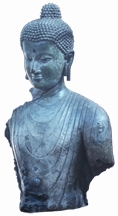
Classical high art Sculptures of Bengal the Bengal Hindu sculptures were created over a period of 1000 years and it is consequent that religious and iconographic concepts reached heights during the period. The discovery of many sculptures in recent times reveal a complexity, expanding the horizon of information which was restricted to the Pala and Sena dynasty sculptures.
Copper, bronze, brass, statues of gods-goddesses, and handmade crafts in Bengal the heritage of Vedic knowledge in metallurgy lives on till today in the beautiful art-craft of brassware. The renowned areas for metal items are Chapai Nawabganj in Rajshahi, Dhamrai near Dhaka, Shemulia, Savar and Islampur of Mymensingh, Dariabad and Tangail, also Kagmari and Baghil.
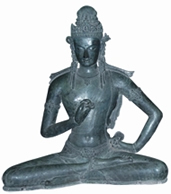
Objects for the temple and religious ceremonies were of high aesthetic quality Ornamentation of the paspapatras or copper plates and bowls for holding flowers and offerings, temple lamps, panchapradips, and the female form lamps the bells or ghantas for awakening the gods, and handle bells decorated with images of the Garuda, Hanuman or bird figures. Trays on stands mounted on a bull or peacock figure are meant for votive offerings. The huge chariots or rath were also elaborately decorated with brass and copper motifs representing mythological themes.
A noteworthy Bengal art-craft is visible in the mat-weaving technique with brass and copper strips to make rice bowls, incense holders and village deities. These were ceremonial items kept alongside the worshipped god during puja and not meant for practical use.
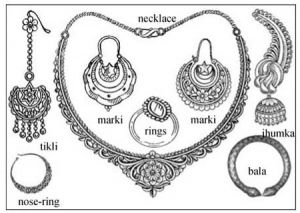
Iconographic art-craft Black stone idols Buddhist and Brahmanical statues in stone, bronze and clay found in East Bengal and preserved at the Dhaka Museum since 1920 were documented in 'Buddhist and Brahmanical Sculptures in the Dacca Museum' by NK Vattasali who mentions the richest collection of Rajshahi Museum and those at Kolkta, Comilla, and Rangpur and private collections. Buddhist iconography in Bengal are acknowledged by art historians as of a high calibre, being carved from a fine grain, hard slate stone, called 'black chlorite,' which was weather resistant and suitable for fine engraving.
Metal iconographic statues are at par with stone sculptures as a classical religious art form in East Bengal. The vocation of metal casting was considered sacred by the Caster and the community. Bengal metal sculptures comprised a mixture of metals, copper, lead, tin with proportions of zinc, iron and antimony. Silver pieces have been unearthed, but only in rare cases were gold sheet used.
Metal casting in the lost -wax method attained a currency and excellence equal to stone-carving, depicting suppleness of human form and gracefulness of expression. Jewellery: alonkar by tradition refers to gold and silver ornaments worn by both men and women which are part of their personal adornment.
The art-craft of gold and silver smithy are among the ancient skills of Bengal dating to a history of at least 500 BC. Jewellery making was a family occupation and the artisans made artifacts for temple and ceremonial occasions, household items for rich homes such as perfume holders, rose-water holders, spoons, water bowls and sword cases. Bengal evolved two special jewellery art-crafts, one, the silver filigree or wire work of extreme delicacy and the lac or resin filled gold and silver bracelets (bala) and hoop earrings, made from paper-thin gold and silver sheet. Folk or rural communities developed a distinct form of ornaments, copying the vivid shapes from nature, leaves, flowers, birds, fish, moon and stars. Decoration was made in silver and gold for every part of the body, ears, nose, neck, arms, wrists, fingers, waist, hips, ankles, toes, forehead and hair.
Classification and status of art and crafts historically, the objects of arts and crafts were produced with specific intents such as (a) utilitarian items (b) ritual and ceremonial items (c) personal decoration (d) community requirements in structural architecture (nomadic, tribal, pastoral, agricultural) (d) implements of settled rural communities (e) trade and commercial items (shells as currency, metal coins etc) and (f) beautified objects for visual pleasure, ceremony and enjoyment. Patronage of the priesthood, royalty and rich classes played a role in the production of handmade crafts.'
The hierarchal Brahmanic culture followed by the Hindu caste system held its influence over art-craft production. Skills were inherited from generation to generation because the religious system made it specific as to what caste will do what without any deviation. There were castes for producing objects of utility aesthetics what we call now arts and crafts. All arts and crafts can be categorized into many categories such as, ritual crafts, tribal crafts, folk crafts, traditional crafts, classical high art, people's art / popular art, folk utility crafts and contemporary crafts.'
Ritual crafts Socio-religious cults among the ancient people of deltaic Bengal were steeped in rites and customs surrounding mystical beliefs, fear of the unknown and appeasement of deities. Such rituals led to the use of various objects to carry out the ceremony, resulting in the object itself becoming a sanctified item.
Earthenware artifacts clay oil lamps (prodeep) for puja, bowls and plates (thali) for bhog or food for the gods, clay idols of lesser deities in the shape of dolls, horses, elephants, tigers, cats, dogs, carriages (bohanas) vases, cooking pots etc.

Ritual Basketry Saji, a twig-woven handle basket shaped to hold flower heads and petals to sprinkle on idols and statues is carried by women to the river side and temple to perform puja.
Winnowing tray Kula a u-shaped cane object is essential to agricultural societies in winnowing rice from chaff. It holds significance in Bengal at wedding ceremonies and birth of a child.
Vermillion sindur is the vermillion colour used in the parting of a married woman's hair, symbolic of her marital status. Its ritualistic implication refers to the consumation of the marriage and breaking of the hymen.
Crown topor a multi-tiered headgear made from shola cork pith, worn by the Hindu bridegroom comprises the ceremonial wedding dress code.
Bride's tiara' Kapali is worn by the bride on the forehead, over her bridal veil. It is made from the shola pith and is embellished with hanging flowers on the sides.
Garlands Mala made from intricately sliced, carved and pasted flower petals cut from the shola cork plant by professional artists called malakars, is an important part of the wedding ceremony. Both bride and bridegroom garland each other with the mala.
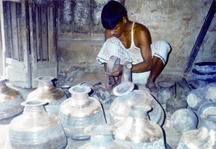
Loyalty-vow wristband Rakhee bondhon is the tieing of a twisted thread band. This ritual is performed, usually before the wedding, at the gaye-halud (tumeric) ceremony.
Conch shell shabkha is a ritual item blown as a trumpet at Hindu religious ceremonies marking weddings, births, deaths, victory and to commence puja. The ritual shabkha bridal bracelets crafted from conch shells, carry further significance as a sanctified object.
Rath and temple drapes are cut, sewn and embroidered for decorating the chariot or rath, and as drapes around the deity’s altar. These cloths bear diagramatic art motifs culled from the repertoire of patterns associated with the god being worshipped. The annual rath jatra held at Dhamrai to honour Lord Jaganath is preceeded by elaborate preparation’s to decorate the chariot.
Brass, bell metal, and alloy metals petol, kansa, tamba crafting of artefacts for temple worship is an ancient profession of artisans since the first settlements in organised societies of the Indo-Gangetic Valley civilisation. Objects for ritual ceremonies included bells, gongs, musical instruments, water pitchers, bowls, plates, oil lamps, stand lamps and the multitudinous statues in bronze, silver and gold plate. According to Hindu Tradition special utensils were made to carry out rituals at the riverside, at cremations, births, weddings and festivals.
Tribal crafts the tribal societies produced varieties of arts and crafts of religious and utilitarian values. Every tribe produced uniques items of arts and crafts. Sacred textiles and their techniques of production establish their value as religious artefacts. Handspun cotton, natural dyes, ancient looms and secret rituals were the hallmarks of fabrics woven among the tribal communities of Bangladesh. Every tribe produced some unique arts and crafts which were produced to serve the purposes of their religious practices.
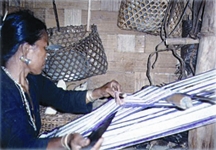
Ther tribal societies developed unique styles making jewellery and other artefacts in consanence with shapes and designs drawn from nature. Earrings shaped like spider-webs were called ‘makor’ and a waist belt having hundreds of twined silver wires was named bichhu as it looked like a centipede.A millenia ago the influx of tribal people from Assam, Tibet, Burma and Mongolod clans brought in more exotic designs. As was typical of all eastern art, none of the patterns lack in symbolism or ritual significance.
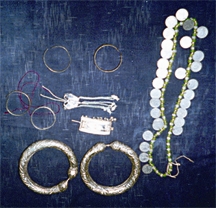
Nag phul (nak phool) is a nose decoration worn on the left side of the nostril, shaped like a small star.
Sonar nak phul or sona noth A good stud is worn on the left side of the nose in a variety of floral or geometric shapes.
Bali is a ear ornament worn in the pierced lobe of the ear, shaped like a simple ring.
Yarrin is similar to the common earring worn all over the subcontinent and is either fitted to the lobe or hangs from it by a hook.
Haza phul is a petal shaped ear-top held by a screw or ' push' behind the ear.
Kan phul is a fitted top shaped like a star, worn on the ear lobe.
Jhunga is like the subcontinental jhumka, a bell shaped ornament with or without a small fringe of tiny balls, worn dangling from the ear.
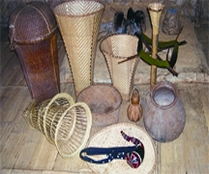
Jhumali is a flat flower shaped gold or silver earring worn on the lobe with a small hook.
Aajuli or honduli is a crescent shaped necklace made up of pieces of flat silver which can be stretched to fit around the neck in a semi-circle.
Tenga chara or taka chara is a necklace of silver coins strung on a twisted cotton thread. called adhuli chara and siki chara.
Chick chara is a collar band neck ornament of either silver or gold.
Aal chara is a wedding ornament comprising of three long chains made out of small floral shaped pieces of silver joined at the top by triangular pieces of silver.
Chandra har is the same as the ancient Vedic-Hindu necklace and chest decoration shaped with long strings of silver or gold pieces hanging from semi-circle medalions and held by chains at the uppermost part.
Tajjur is a rounded arm band shaped like a bracelet but with one section flatened and embedded with precious stones or engraved.
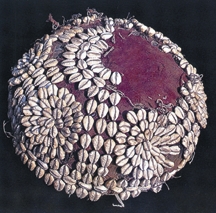
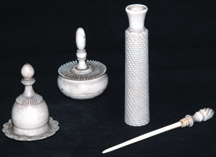
Teluli chara is similar to the Taj jur and is also called by the subcontinental name bajuband. The arm band is made out of separate silver pieces laced together with cotton threads, so as provide flexibility.
Banguri is a thick silver circlet forming a bracelet worn at the wrist.
Churi is a bangle of gold of medium thickness with engraved designs or cutwork.
Angti is a finger ring with stone setting or a plain circlet.
Thengakkaru or payer kharu is a pair of anklets made of silver weighing upto forty tolas. The circlet is slipped over from the toes to the ankles.
Jal taranga is similar to the thengak karu but is light in weight as it is hollow, like a pipe, but has engraved designs on the surface.
Jhunjhuni is a thin silver circlet with seeds attached to the twisted chain, given to babies to wear around their waist.
Gunguru is an anklet for babies with tiny seeds or bells attached to the silver ring which create a tinkling sound as the baby walks or crawls.
All the above items are used in ceremouse and rituals.
The Chakma loom Aesthetically most well known and significant object in the chakma household is the baen, or' loom. It has twelve main parts, nearly all made from bamboo and the chhaw betal nut tree.
Every Chakma girl is taught weaving by her mother and elders and the skill is inherited within the family from generation to generation.. The baen skill is considered a qualification of a good wife and mother and a spiritual value is given to the art of weaving.
At about eight years of age a girl is encouraged to start learning a range of designs, which her mother shows her from an heir-loom woven catalogue. This is called the aalum.
Santal crafts The use of natural plants, fibres, leaves, tree trunks and bark are part of the hand made artifacts used for domestic and ceremonial use.
Fabric weaving is traditional on bamboo looms, carried out by Santal women, for their personal use. The phota is a thick cotton thread woven into an upper and lower garment for women, and a lower garment for men, called dhuti.
Santals wear silver jewellery on various parts of the body as is common in the Indian sub-continent. Churi for the wrists, nath for the nose, makri for the ear, bichha around the waist, seenti-pati in the hair parting, hansuli or manduli around the neck, and onguri is worn on the big toe. Armbands called baju, anklets called banki and kaner-dul earrings comprise the ornaments.
A distinctive decoration of women is flowers, worn profusely at festivals, behind the ears kajali ximul and champa and garlands of many wild flowers.
The Garos are a hill people originating from the Meghalaya region of India. After the khasi tribe they are the largest in India, and moved to the areas now in Bangladesh approximately 400 years ago. They inhabit in the districts of Tangail, Jamalpur, Sherpur, Netrokona, Gazipur, and are thinly spread over Rangpur, Sunamganj, Sylhet and Maulvibazar.'
Garos weave a range of textiles for personal and domestic use on their ancient bamboo and wool looms. Their main garments are the dok-manda, ganna, butrang of orhna scarf and hopping or head turban.
The women as skillful in making bead necklaces and head decorations. The rik machu is a glass head mala or long necklace, the ribbock a necklace of ivory bits, khok kaxil a silver forehead decoration, demg gachhru a silver coins necklace and the exotic head crown of bird feathers called, domee-murgher. The men's turban is called khatup and is wound around the head like a pugree
The Garos had inherited various mystic objects for protection from dangers. These took the form of talismans to be worn by every person. A large iron necklace called antik-silara is worn by men and women if they are to overcome any danger or sickness. Another protective object is the nakuri an iron ear-cover worn from the head like a helmet. Iron bangles called jaksil, jakchop and samthang are worn on upper arm and wrists for health improvement.'
Traditional art-crafts Scroll painting writing and diagramatic art were part of the Buddhist-tantric tradition of 5000 years, using a variety of base materials such as palm, leaf, bamboo strips, papyrus (processed and seasoned leaves or bark) and cloth. The best of Bengali folk culture bore fruit between the 13th and 15th centuries. In Bengal folk artists used the art of painting on scrolls or lengths of cloth wound over short wooden poles to relate legends and folk tales as they travelled from village to village. These stories coming from the Indo-Gangetic tradition of Ras-leela or Krishnaleela, Ramleela and Brahmanic gods, metamorphosed over centuries to depict folk interpretations from Hindu sources such as the Mahabharata and Ramayana. Islam bought stories of the Karbala, Bibi Fatema, Hazrat Hassan and Hussain and a fascinating collection of folk heroes. Gazi Pir and Satya Pir, protectors against the tiger and Bon bibi against dangers in the Sundarban jungles, appeared in the famous gazir-pat genre.
Lakshmicasket (lakshmi bati or Tukri) is a symbolic cane basket covered with red shalu cloth encrusted with cowries shells, dedicated to Lakshmi, goddess of agriculture, wealth and prosperity. The cowries, which were ancient monetary exchange in trade, are sewn onto the Lakshmi basket in the shape of lotuses, symbolic of the goddess.
Horn and bone crafts Moiusher sheeng Dhaka's by-lanes have been the home of a unique traditional craft by chiseling shaping and engraving buffalo's horn. The skill developed among Muslim artisans in the 18th century who discovered that horn could be used as raw material to turn out sturdy hair combs, buttons, hair-clips, pen holders, and a variety of decorative items. Walking sticks and lamp stand found buyers among the rich and genteel classes. Despite competition from plastics the craft lives on in the beautiful burnished artifacts for home and office.'
Muslin and jamdani The gem of loom weaving in Bengal is the finest of fine cottons called 'muslin' These excellent diaphanous gossamer-like fabrics were woven at least 2500 years ago along the riverbanks of Sitalakhya where the damp air kept the fine threads from breaking. Weaving was accompanied by ritual and followed seasonal patterns, the weavers rising before dawn to set the warp before the sun became too hot.
The celebrated Dhaka Muslins were later in time patronised by the Muslim rulers bringing in the figured designs that gained the name of jamdani (wine-carriers) a metaphorical connotation of the transparency and charm connected to sparkling wine. The status of jamdani as a legacy of an ancient art-craft of the loom holds its place in the annals of classic weaving traditions, and a living art-craft of today.
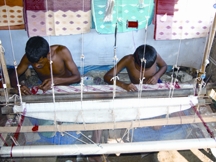
Cloth decoration or cloth architecture it is a form of using textile materials stretched, folded and draped on bamboo structures to create gateways, arches, hall spaces (pandel) and dais (manch) platforms. The craft has a traditional root being constructed in villages and towns since time immemorial for weddings and festivities to signify the entrance and place of ceremony.
In the last two decades and coining a new name 'cloth architecture', entrepreneurs have set up commercial services for display and decoration at 'event management'. Using bamboo or cane frames or light iron rods the designers offer displays not only for weddings and parties, but for conferences and sales promotion. The displays integrate many new materials such as flowers, ribbons, foam cut-outs and lights.
As a people's craft, cloth architecture has seen transformation in the past decade for open-air public functions at melas and religious gatherings such as urs and waz-mahfil. Elaborate bamboo structures are built in shapes of mosque or mazar domes and minarets, as fortresses (qilla) and Islamic architectural forms.
Hindu puja mandaps in the villages all over Bangladesh have used bamboo structures artistically ornamented with paper cut-outs through the centuries. Gopalganj, Faridpur, Mymensingh, Rajshahi and Chittagong put on the best mandap displays with paper cut-outs during Durga puja.
The cloth tying and draping techniques have undergone remakable changes from the traditional village displays, promoting cloth architecture into a modern art-craft status.
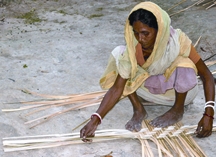
Basketry-mat weaving tukri, jhuri, dhama, madur, hogla, pati etc baskets are a natural collorary in an agricultural society, used for various lifting and storing needs, and in Bengal the profusion of bamboo, cane, grasses, reeds, leaves and fibers has given great vent to the creativity and skills of artisans. Basketry as a craft adopts techniques of weaving, coiling, twisting, chequer work or twilled work and the heavy wicker or stalk-work to produce the hardy jhuris and dhamas used for earth lifting.
The durability by soaking processes in hyacinth ponds and muddy pools, the finishing with anti-insect resins and the coating of the gab fruit juice gives Bengal's basketry its recognized bronze hue and reliability. Mat weaving for practical use as sleeping mats, seating mats, food drying mats, shade-giving roof mats, partition wall mats, false ceiling mats, wall mats or darma and prayer mats are carried out all over the districts and villages of Bangladesh. [Parveen Ahmed]
